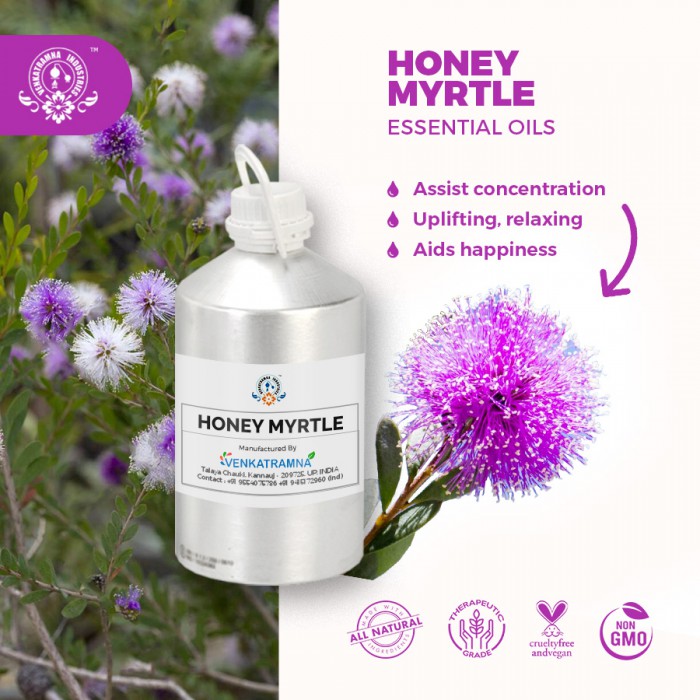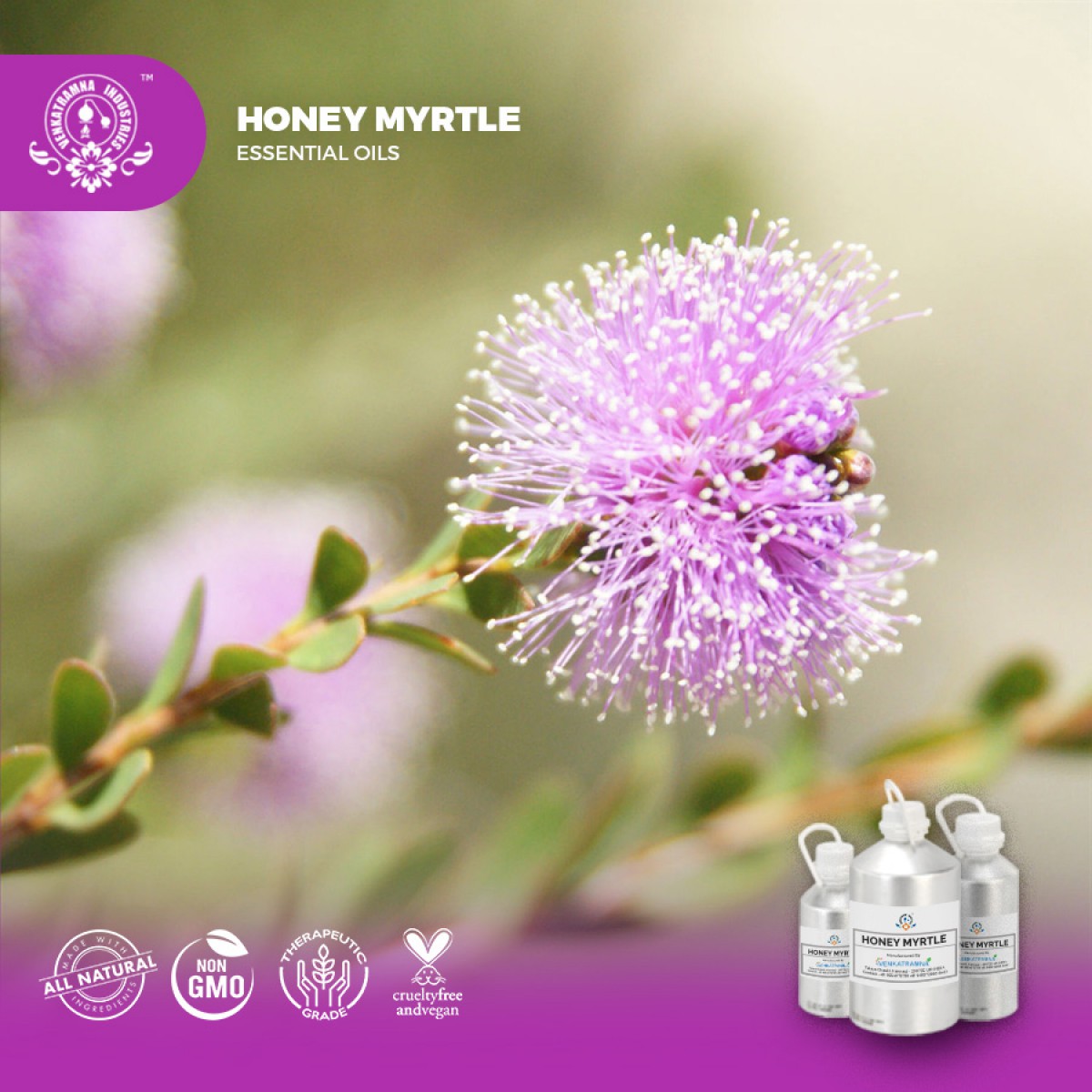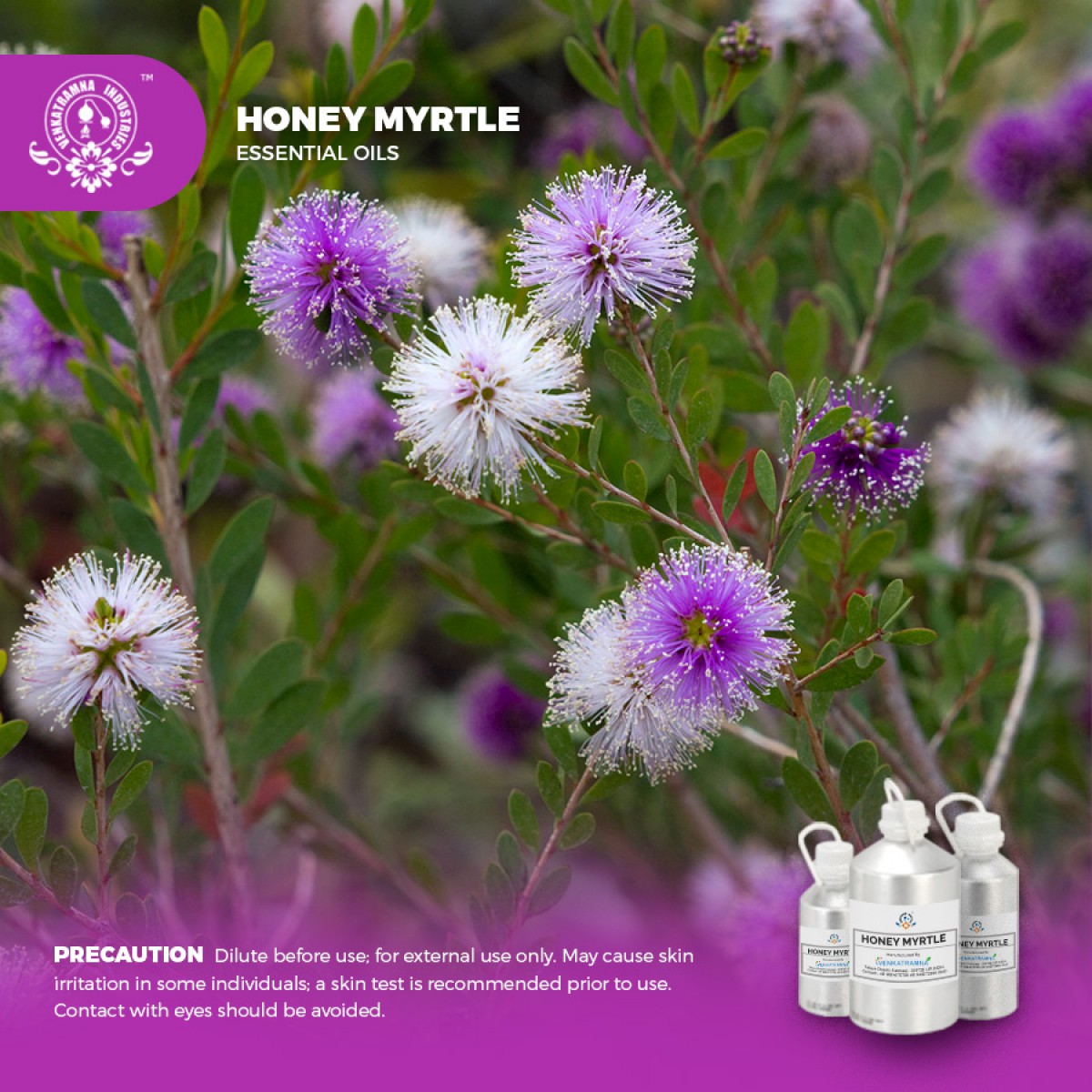Botanical Name: Melaleuca teretifolia Common name: Honey myrtle Pl Read More
|
Botanical Name: |
Melaleuca
teretifolia |
|
Common name: |
Honey myrtle |
|
Plant family: |
Myrtaceae |
|
Genus: |
Melaleuca |
|
Appearance/Color: |
Thin liquid with
clear to yellow color |
|
Odor: |
Fresh watery scent
with citrus lemon honey |
|
Blends With: |
Blue cypress,
emerald cypress, eucalyptus varieties, nerolina, sandal wood or tea tree |
|
Origin: |
Australia |
|
Source: |
Leaves |
|
Method of
Extraction: |
Steam Distillation |
Honey myrtle essential oil has the highest Citral content of
all Melaleucas plants and has significant perfumery potential. It is
widely known as deodorizer because of its great antiseptic properties and
citrus fragrance. Honey myrtle is a
great oil to be used in a vaporizer or oil burner around the home to add a
light clean scent as well as killing germs.
Honey Myrtle oil is steam distilled from the leaves, middle and terminal branches of Melaleuca teretifolia; a shrub unique to Western Australia. Being rich in citral (typically 70 – 85%) this essential oil has a sweet lemon fragrance with soft citrus undertones presenting a pleasant environment.
DISCLAIMER
The complete range of conditions
or methods of use are beyond our control therefore we do not assume any
responsibility and expressly disclaim any liability for any use of this
product. Information contained herein is believed to be true and accurate however,
all statements or suggestions are made without warranty, expressed or implied,
regarding accuracy of the information, the hazards connected with the use of
the material or the results to be obtained from the use thereof. Compliance
with all applicable federal, state, and local laws and local regulations
remains the responsibility of the user.
The FDA has not evaluated the
statements on this website. No claims are made by Venkatramna Industries as to
the medicinal value of any products from vriaroma.com or by us. The information
presented here is for educating our customers about the traditional uses of
essential oils and is not intended to diagnose, treat, cure, or prevent any
disease. You are responsible for understanding the safe application of these products.
If you have any questions, please call or email us for further information.
As per NAHA guidelines, New Directions Aromatics
(NDA) does not recommend the ingestion of essential oils. It is imperative to
consult a medical practitioner before using Essential Oils for therapeutic
purposes. Pregnant and nursing women and those taking prescription drugs are
especially advised not to use this product without the medical advice of a
physician. The oil should always be stored in an area that is inaccessible to
children, especially those under the age of 7.
Honey
Myrtle oil is loved for its exotic and calming scent, making its most usage in
perfumery and skin care cosmetics. Its anti-septic
and skin clarifying properties has wide range of application in skin care
products. The anti-viral properties may help you
strengthen your immune system.
Honey Myrtle oil in Pharma
Honey Myrtle oil has specific anti-inflammatory, antifungal, antibacterial,
analgesic, antispasmodic actions pharmaceutically. The sweet citrus flavor has
mood relaxing effects.
It re-nourishes skin, and removes bacteria by its
antibacterial action. This makes it effective in inflammation and skin
irritation. It works well in fungal infections like athlete’s foot and any open
wounds.
Essence of Honey Myrtle
oil
Honey Myrtle oil has uplifting
and mood lightening effect is most used in air purifiers and deodorizers. Its
citrus flavor drives away insects and is used in insect repellents.
COMMON USAGE
·
Increases immunity to viral infections because
of antiviral properties
·
Insect repellents
·
Mind relaxing
·
Calming effect on mind
·
In skin care to treat acne, blemishes
·
Antispasmodic
·
anti-inflammatory
·
antifungal
·
antibacterial
·
analgesic
Ingredients:
|
S.No |
Key Constituents |
Strength (%) |
|
1 |
Geranial |
37.5 |
|
2 |
Neral |
29 |
|
3 |
b-myrcene |
10.9 |
|
4 |
Geraniol |
3.4 |
|
5 |
Nerol |
2.8 |
|
6 |
(E)- isocitral |
2.3 |
|
7 |
1,8-cineol |
2.0 |
|
8 |
(Z)-isocitral |
1.5 |
|
9 |
a-pinene |
1.2 |
|
10 |
Geranyl acetate |
1.0 |
TOXICOLOGICAL
INFORMATION
Safety Summary
Keep
away from direct light and UV radiation. Keep in the amber glass bottle with lid tightly
closed. Only open when you need to and decant into a smaller
"working" amber glass bottle if possible. This is to reduce
oxidation. It
is better to store in a refrigerator.
·
Cautions oral: diabetes medication and pregnancy
·
Caution dermal: hypersensitive, diseased or damaged skin, Children
under 2 years.
Organ Specific Effects
·
Adverse skin reaction: no information
found. Citral is potential skin sensitizer.
·
Reproductive toxicity: citral is
potential teratogenic since it can inhibit retinoic acid synthesis and can affect
fetal development.
Systemic Effects
·
Acute Toxicity: no information found
·
Skin corrosion/irritation: may be irritating to
skin
·
Carcinogenicity:
no information found. Citral and geraniol have anticarcinogenic properties.
ECOLOGICAL
INFORMATION
·
Toxicity:
PNEC oral: No data available
EC50 (48hours): No data available
LC 50(96hours): No data available
·
Bioaccumulation: No data available
·
Mobility in soil: No data available
·
Persistence and degradability: No data available
·
PBT and vPvB assessment: No data available
·
Other adverse effects: Do not allow it to enter
into water systems and marine environment.





 MSDS-Honeymyrtle.pdf
MSDS-Honeymyrtle.pdf




